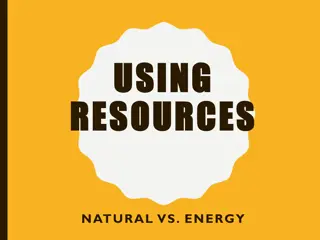Understanding Energy Resources in Environmental Studies
Explore different types of energy resources, including non-renewable and renewable sources, such as coal, petroleum, natural gas, LPG, and CNG. Learn about their properties, benefits, and environmental impacts in the context of energy sustainability.
Download Presentation

Please find below an Image/Link to download the presentation.
The content on the website is provided AS IS for your information and personal use only. It may not be sold, licensed, or shared on other websites without obtaining consent from the author. Download presentation by click this link. If you encounter any issues during the download, it is possible that the publisher has removed the file from their server.
E N D
Presentation Transcript
Course e-Content Environmental Studies Energy Resources
Energy Resources Energy resources are those sources from which we can harvest energy. Energy resource can be of two types i.e. 1. Non renewable (Conventional) Energy resources. 2. Renewable (Non conventional) Energy resources.
Non renewable Energy resources These are the energy resource that are present in a limited quantity and takes long time to form it. If they used continuously they will be depleted .These sources are pollution causing .they are not eco friendly. These take long time to form and once used cannot be regenerated. For example fossil fuel, coals, natural gas etc. The calorific value of non renewable sources are much higher than renewable sources.
Non renewable Energy resources 1. Coal : Coal is formed from the vegetative matter buried beneath the earth. Coal is the most abundant fossil fuel. The coal is of three types ie; Hard coal (anthracite) It consists about 92-98% of carbon having highest calorific value- 7500- 8100kcal/gm. Soft coal (bituminous)- It consists about 75-83% of carbon and calorific value is 6100-6500kcal/gm. Brown coal (lignite) It consists 60-70% of carbon and calorific value is 5000-6000kcal/gm.
2. Petroleum: It is found beneath the earths surface. It is formed by the decay of microorganism living in the sea by heat, pressure and catalytic action. In India the oil drilling centers are Digboi, Dibrugarh, Narharkatiya, Makum, Bay of Cambay, Bombay High etc. It is cleaner source than coal with high calorific value. 3. Natural Gas: It is mixture of hydrocarbons and methane (96%). Natural gas deposits often accompany oil deposits or may occur independently. It can be easily transported through pipelines.
4. LPG: It is liquefied petroleum gas. It is used for domestic purpose. It is mixture of butane propane. It is obtained by converting petroleum into liquid form under pressure. 5. CNG: It is compressed natural gas which is used as an alternative to petrol and diesel for transport of vehicles. It is cleaner source than diesel.
Renewable Energy resources These are that energy resource that are present in a enormous quantity and can regenerate again and again. These sources are not pollution generating .they are eco friendly. These can be generate from natural source. For example wind energy, solar energy, geothermal energy, tidal energy, biogas etc.
1.Solar energy: It is most accessible and easiest source of energy. India because of its geographical location receive high intensity of solar radiation. PV cells convert the solar energy into electricity. It produce electricity from sunlight through an electronic process. It is made of silicon a semiconductor material. 2. Wind energy :Speed of wind can be used to run wind mills for generating electricity, irrigation and grinding grain. The development of wind power in India began in the decade of 90s, has shown rapid growth and India has become the fifth largest installed wind power capacity in the world.
3.Biogas: Biogas is a renewable energy source and refers to a mixture of different gases produced by the breakdown of organic matter in the absence of oxygen. The organic materials can be agricultural waste, manure, municipal waste ,plant material, sewage ,green waste or food waste. Biogas can be produced by anaerobic digestion with anaerobic bacteria, which digest material inside a closed system. The main components of biogas are methane, carbon di oxide, carbon mono oxide and hydrogen Sulphide.
4. Geothermal energy: It is the energy that is generated in earth crust and core. The inner core of earth is surrounded by magma which is in hot molten state and it warms the surrounded underground water and the source of hot springs. Geothermal energy can be used directly as hot water or indirectly by generating electricity. 5. Hydro Power : water falling from height turns turbines at a bottom of DAM to generate electricity. Water power is a clean source of energy, it generates about 25% of world electricity. In India, the hydro power generating stations are Bhakra Nangal, Nagarjun Sagar and Damoder Valley.
6. Tidal Energy: tidal energy is the form of hydro power that converts the energy of the tides into electricity. Tides are created by gravitational pull of the moon and Sun along with the rotation of the earth and causing cyclical movement of the seas. The tides are strong to move the turbines to generation of electricity. Turbines are fixed tunnels which rotate when water flows through them. The two way tidal power system generates electricity from both the incoming and outgoing tides. The tidal power stations are Gulf of Cambay and Gulf of Kutch, Ganga Delta in Sunderban region etc.
7. Hydrogen Energy: it is clean source of energy. It involves the use of Hydrogen and hydrogen containing compounds to generate energy. It uses hydrogen as a fuel for thermal power generations. Hydrogen power generation requires a large amount of hydrogen as a fuel. It is envisioned as future fuel such as hydroelectric power generation and wind power generation today. 8. Bio-Fuel : The fuel obtaining from biological materials is called as Bio fuel. For example, Bio Ethanol, Bio Diesel etc. Bio diesel can be obtained from oil seed plants. These are non petroleum based diesel fuel consisting of short chain alkyl asters made by esterfication of vegetable oil. Jatropha plant seeds containing 21-48% oil and used as source of Bio Diesel.
Uses of alternate energy source Any energy source that provide alternate to fossil fuel, is called as alternate energy source. These are clean source of energy and carbon emission is zero or very limited, that s why these are also called as eco-friendly or green source of energy. Alternative energy is the energy that does not come from fossil fuels as source, and thus produces less or no harmful gases like Methane, carbon dioxide , Sulphur di Oxide and Oxides of Nitrogen. The energy produced from alternative sources does not contribute in the greenhouse effect that causes climate change. These energy sources are referred to as alternative because they represent the alternative to fossil fuels, which have been the most common sources of energy since the Industrial Revolution. These fossil fuels are not eco friendly and produce lots of harmful gases including highest levels of CO2.
The alternate energy source are : Solar Energy Wind Energy Geo-Thermal Energy Bio-Fuel Bio Gas Nuclear Energy Hydrogen Fuel Thermal Energy Wave Energy Tidal Energy
Growing Energy Needs The development in various sectors relies largely upon energy. With increasing per capita demand of growing population the world is facing shortage of energy. Increasing per capita consumption of energy is related to the extent of development. India is an agriculture based country and majority of population lives in villages and uses wood and dung, agricultural waste as energy source. In urban cities in industries transportation etc, the energy conceived is derived from petroleum, coal, natural gas, hydro power and Nuclear power. The industries claim a large share i.e. about 40% of total energy followed by transportation (about 32%), domestic establishment about 14% and the rest in agriculture. Industrialization and population rise coupled with rapid urbanization are the main causes of this increase. Petrol, diesel, gasoline and CNG are largely used in transport. The installed generation capacity is not matching the demand. To overcome with the increasing demand, the alternate energy programs have been developed on priority basis. In every field like farm sector, domestic sector and transport the needs of energy is very high. One reason between gap of demand and supply is mismanagement in power distribution.
Agro-Residues as a Biomass Energy Source The agricultural residue is the by-products from harvesting of agricultural crops. These agricultural residues are used as energy source. Many agricultural wastes are used to produce energy by burning. For example Sugarcane residues, coconut shells etc. Animal dung, fishery and poultry waste and human refuse can be used to produce energy. In India about 80% of rural heat energy is obtained by burning animal dung cake, agricultural waste and wood in Chullahs which produce enormous amount of smoke. The chullahs, apart from smoke produce a lot of ash and waste residues. Agricultural residues are highly important sources of Biomass fuels for both the domestic and Industrial sectors. Crop residues can be all agricultural wastes such as straw, stem, stalk, leaves, husk, shell, peel, pulp, stubble, etc. which come from cereals (rice, wheat, maize or corn, sorghum, barley, millet), cotton, groundnut, jute, legumes (tomato, bean, soy) coffee, cacao, tea, fruits (banana, mango, coco, cashew) and palm oil.
Energy Contents of Coal, Petroleum, Natural Gas and Bio Gas For every kilogram of coal that gets burned, a total of 2.312 107Joules of energy gets released. For every kilogram of oil (in the form of gasoline) that gets burned, a total of 4.64 107Joules of energy is liberated. For every kilogram of LNG that undergoes combustion, 5.36 107Joules of energy can be gained. Each cubic meter of biogas contains the equivalent of 6 kWh of heat energy. The average calorific value of biogas is about 21-23.5 MJ/m , so that 1 m of biogas corresponds to 0.5-0.6 l diesel fuel or about 6 kWh























